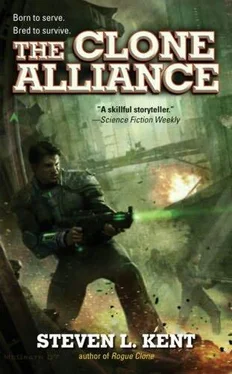Steven Kent - The Clone Alliance
Здесь есть возможность читать онлайн «Steven Kent - The Clone Alliance» весь текст электронной книги совершенно бесплатно (целиком полную версию без сокращений). В некоторых случаях можно слушать аудио, скачать через торрент в формате fb2 и присутствует краткое содержание. Жанр: Боевая фантастика, на английском языке. Описание произведения, (предисловие) а так же отзывы посетителей доступны на портале библиотеки ЛибКат.
- Название:The Clone Alliance
- Автор:
- Жанр:
- Год:неизвестен
- ISBN:нет данных
- Рейтинг книги:4 / 5. Голосов: 1
-
Избранное:Добавить в избранное
- Отзывы:
-
Ваша оценка:
- 80
- 1
- 2
- 3
- 4
- 5
The Clone Alliance: краткое содержание, описание и аннотация
Предлагаем к чтению аннотацию, описание, краткое содержание или предисловие (зависит от того, что написал сам автор книги «The Clone Alliance»). Если вы не нашли необходимую информацию о книге — напишите в комментариях, мы постараемся отыскать её.
Rogue clone Wayson Harris is stranded on a frontier planet-until a rebel offensive puts him back in the uniform of a U.A. Marine, once again leading a strike against the enemy. But the rebels have a powerful ally no one could have imagined.
The Clone Alliance — читать онлайн бесплатно полную книгу (весь текст) целиком
Ниже представлен текст книги, разбитый по страницам. Система сохранения места последней прочитанной страницы, позволяет с удобством читать онлайн бесплатно книгу «The Clone Alliance», без необходимости каждый раз заново искать на чём Вы остановились. Поставьте закладку, и сможете в любой момент перейти на страницу, на которой закончили чтение.
Интервал:
Закладка:
“The war,” I answered. “The whole specking war.”
CHAPTER TWENTY-ONE
“I heard the last pilot you took out here got fried,” our pilot said as we glided into the space graveyard on our way to the Mogat battleship.
Looking out from the cockpit of the explorer, I saw no sign of that last ship. It had simply vanished into the debris, pilot and all. We might nudge it out of our path and not notice.
“We’ll be more careful this time,” I said.
“How is that?” the pilot asked.
“Last time we didn’t know the Mogats were watching for visitors. This time we do.”
“I hope you don’t expect me to wait around for you,” the pilot said.
“Yes, I expect you to wait till we tell you to leave. Waiting wasn’t what killed our last pilot. He got killed running away. If he’d just sat still and blended in with the scenery…” I let the sentence hang.
In order for my plan to work, we needed the Mogats to know we had trespassed onto their property, and to think they had scared us away. The best way to do that was to give them a show.
As we approached the battleship, the pilot scanned for booby traps and burglar alarms. Once we boarded the derelict, we would use the stealth kits I had requisitioned from naval headquarters. Until then, we would need to rely on the explorer’s sensors. Fortunately, this was a scientific ship. It had sensors that could pick up all kinds of fields. The coast seemed clear, but there was one kind of signal the vessel would not detect—a signal transmitted by a broadcast engine.
As we opened the cargo hatch and started to unpack, the pilot hailed me over the interLink. “I’m not waiting around,” he warned. “Listen, Sergeant. Command said nothing about babysitting a bunch of clones on a suicide mission. If I get a whiff of a Mogat ship, I am going to leave.”
“They won’t find you if you hide, sir,” I said. “They will find you if you run.”
“Then maybe I should leave now,” the pilot said.
“We’re still on your ship, sir,” I pointed out.
“I mean once you are off.”
“Are you talking about abandoning us?” I asked. “Don’t you think someone will ask questions when you show up short forty-two men?”
“No, I don’t. Not if they are clones.”
They had a term for officers who were prejudiced against clones—“antisynthetic.” In my experience, most officers were antisynthetic to some extent, but things were changing. There used to be six hundred clone factory/orphanages pumping out over one million clones every year. Now that the Mogats had destroyed the orphanages, clones were no longer the inexhaustible resource they had once been. Once the military complex ran out of its current supply of clones, the government would have to start sending natural-borns to the front. After years of relying on clones to do their fighting, few natural-borns would willingly fight or die.
“You strand us out here, sir,” I growled, “and you’d better pray the Mogats find you before I do.”
“Are you threatening me, Sergeant?” the pilot asked.
“Yes, sir,” I said.
“You have just officially crossed over the…”
“Maybe we should take this up with Admiral Brocius,” I said. “He’s the one who assigned you to this platoon.”
“Admiral Brocius?” the pilot asked.
As a lieutenant, the pilot outranked me. But rank and authority did not always mean the same thing in the Marines. A veteran sergeant is at the top of the arc as enlisted men go. He may not make as much money as the lowest-paid officer, and he may sleep on a mean rack in dingy barracks, but an experienced sergeant merits more respect than a lieutenant who is still wet behind the ears.
A master gunnery sergeant is a veteran and a man who knows his way around the Corps. Let a lieutenant and a master sergeant go head-to-head, and the sergeant may take a token vacation in the brig; but unless that lieutenant has some good answers, his career will be specked for good.
That said, I’m not sure which rattled the lieutenant more, my bringing up Admiral Brocius or my threatening his life. Either way, the good lieutenant decided to park his bird and leave the meter running.
He sidled the explorer right below the sunken Mogat battleship and brought it to a stop. Then it was our turn. We exited the ship in groups of ten, each of us shepherding crates and equipment toward that huge hole in the bottom of the Mogat ship. Nearly a month had passed since I came here with the SEALs. The memories were still fresh in my mind.
The first team on the spot fastened hooks onto the hull and started building a long scaffold that would stretch all the way across the breach. The next crew brought more scaffolding. By the time the third group arrived, enough of the scaffolding had been set to create a staging area. We were preparing to put on quite a show.
Our show props included scaffolds, a complete laser welding rig, crates for storing samples of the ship’s armor plating, and several changes of clothes. We unloaded our props and built the scaffolds in double time. Even though my threats had made our pilot more agreeable, we could tell he was spooked and unreliable.
“That’s the last of the cargo,” I told the pilot, as three of my men ferried over a set of crates on a sled. “Go hide your ship in the debris.” He could not leave yet, but he could park a safe distance away and watch if the Mogats came and massacred us.
The lieutenant did not say anything. The explorer’s engines started, and the ship drifted away, but the pilot did not say a word. We continued building.
First we attached base rods to the bottom of the battleship using a bonding glue that worked better than welding in the coldness of space. Once the rods were in place, we erected the rest of the scaffold using pins and sockets. The work went slowly.
It took us two hours to set up the scaffolding along the battered bottom side of that battleship. That is a long time to spend undefended in enemy space, but we needed it to make our show believable. We had to convince the Mogats that we were naval engineers, come to study the damage to this battleship. As things worked out, we did run one test on the armor plating.
Once the scaffolding was fastened in place, I had two of my men remove a plate from the hull. The plate was a flat square about eight feet along its edges. Had there been gravity, it would have weighed a couple of hundred pounds. In a gravity situation, its bulk would have crushed the thin rods of the scaffolding.
One of my men shoved the plate into space. As it slowly glided away, I drew my particle-beam pistol and fired. The plate absorbed the bright green beam. I thought I saw it quiver slightly, but I might have imagined that. My beam was too small to destroy it, but I wanted to test the integrity of the plating.
In truth, I did not need to test the plating. Looking straight up, I had plenty of evidence about what happens when laser cannons hit an unshielded hull. Rows of plates melt into slag, leaving foot-long stalactites in their wake.
“The stage is in place, Master Sergeant,” Sergeant Evans reported.
The “stage” was impressive. The scaffolding crisscrossed the breach on the bottom of the hull like stitches closing a knife wound. From a distance it might look like stitches. Some of the men built a launch area. If we had been engineers instead of jarheads, we could have spacewalked out to examine the shield antennae.
We spent the next hour removing entire rows of armor plates, some battered and some untouched. We rigged test stations and communications arrays. This was all for show, just a set decoration for the Mogats to shoot at. Once they arrived, our setup scaffolding would prove absolutely indefensible and clearly the work of engineers who had no concept of battle tactics.
Читать дальшеИнтервал:
Закладка:
Похожие книги на «The Clone Alliance»
Представляем Вашему вниманию похожие книги на «The Clone Alliance» списком для выбора. Мы отобрали схожую по названию и смыслу литературу в надежде предоставить читателям больше вариантов отыскать новые, интересные, ещё непрочитанные произведения.
Обсуждение, отзывы о книге «The Clone Alliance» и просто собственные мнения читателей. Оставьте ваши комментарии, напишите, что Вы думаете о произведении, его смысле или главных героях. Укажите что конкретно понравилось, а что нет, и почему Вы так считаете.











